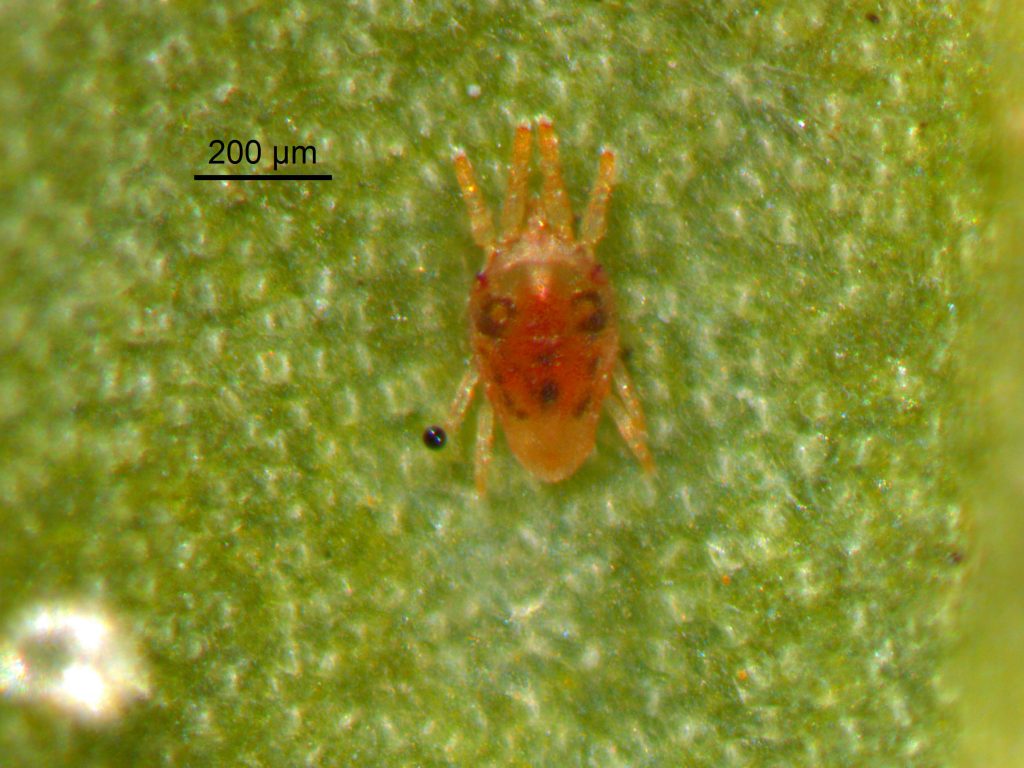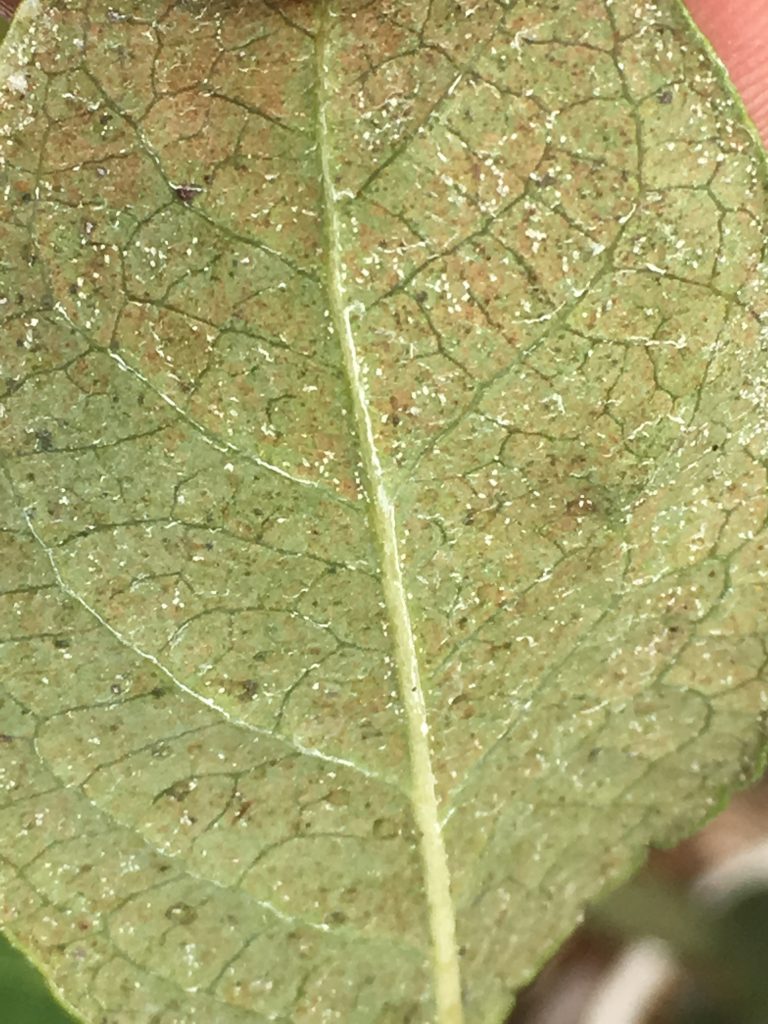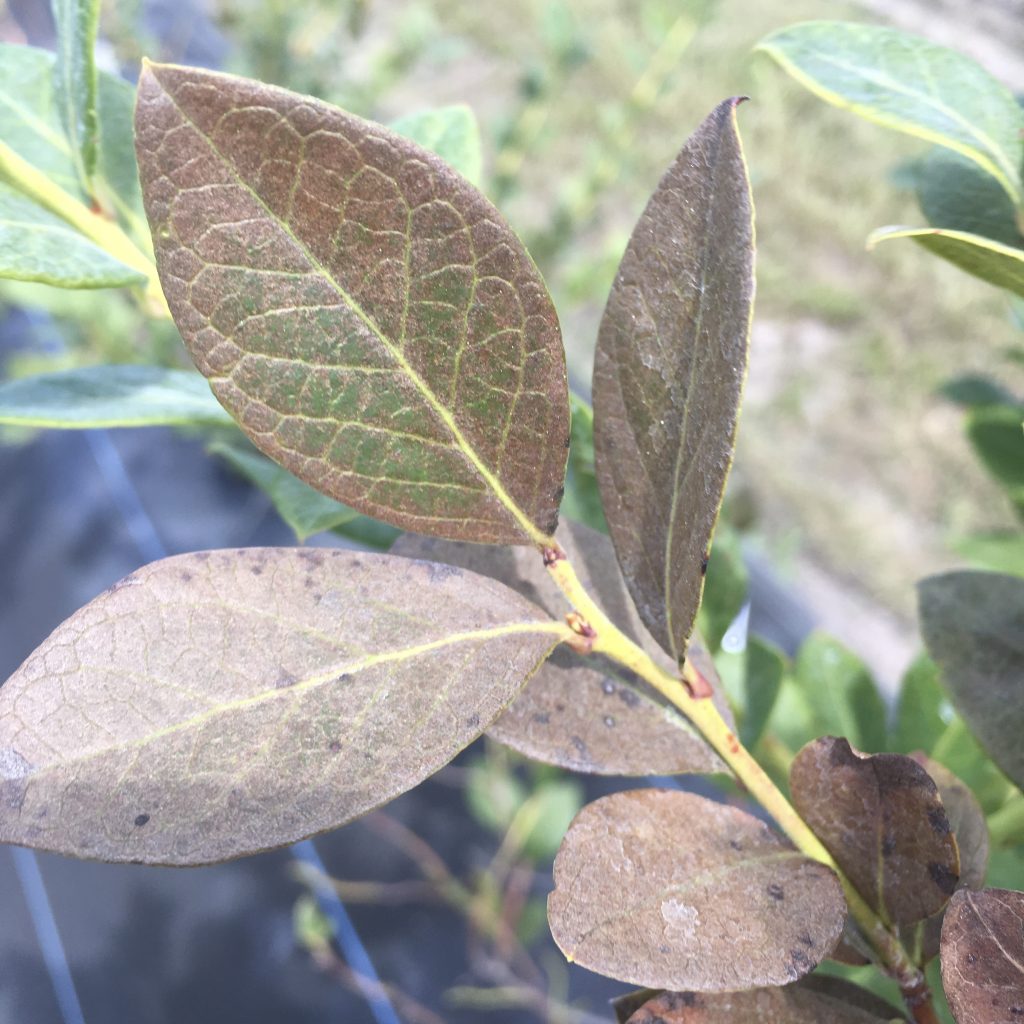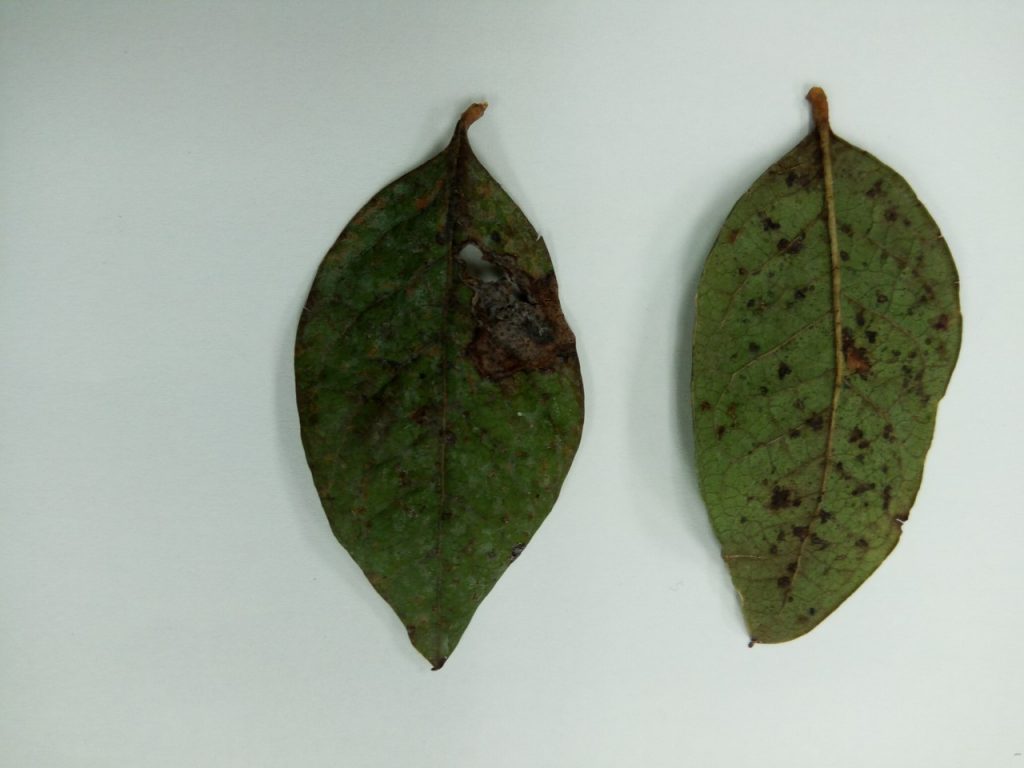
By Oscar E. Liburd, Lorena Lopez and Doug Phillips
Mites can cause significant damage on blueberry plants if not properly managed. Mite species that feed on southern highbush blueberries (SHB) include the southern red mite (Oligonychus ilicis) and the false spider mite or flat mite (Brevipalpus yothersi). The southern red mite is the primary mite pest feeding on blueberry plants in the southeastern United States and is common in fall and early spring. The false spider mite, first reported on SHB in 2016, is more common during summer months.
SOUTHERN RED MITES
In Florida, southern red mite populations increase under dry weather conditions with warm temperatures (60 to 86° F) and reach their peak during the fall. Their life cycle can be completed within two weeks under these conditions, and populations can double within five days with overlapping generations, increasing their potential for significant yield impact.
Adults are similar in appearance to the red form of twospotted spider mites (Tetranychus urticae) and other red Tetranychus species, about 0.4 millimeter in length, red or brown to deep purple in color, with lighter colored legs (Figure 1). Females are slightly larger than males and have a more rounded body shape. Red to brown spherical eggs hatch into pale six-legged larvae. In the nymph stages, mites develop eight legs and are darker and larger.

FALSE SPIDER MITES
False spider mites can complete their life cycle in about 19 to 20 days at around 77° F and 60 percent relative humidity. Adult flat mite females are flat and oval, approximately 0.3 millimeter in length, with red-orange coloring (Figure 2). Males and immature stages (larvae and nymphs) are similar in appearance and color pattern to the females but smaller. Eggs are bright red to orange and elliptical in shape.
DAMAGE
Southern red mites primarily live and feed on the lower side of SHB leaves. An accumulation of shed white skins can be observed when populations reach high numbers (Figure 3). Bronze coloring of leaves is the primary symptom accompanying southern red mite injury, with the intensity of bronzing increasing with the level of internal leaf damage (Figure 4). The southern red mite feeds on plant tissues by inserting its mouthparts into the leaf and removing cell contents, resulting in a decrease in the rate of photosynthesis.
In SHB, leaves heavily infested with flat mites typically develop necrotic brown spots (Figure 5).

MONITORING
In addition to differences in body shape and color, there are other distinctions between southern red mites and flat mites to consider when monitoring for these pests. Flat mites are smaller, move more slowly and are best observed with a hand lens or under a microscope. Southern red mites move more rapidly and can be observed with the naked eye on blueberry leaves. Southern red mites tend to feed over the entire surface of the underside of leaves and produce a web over the infested surface to protect them from predators. Flat mites typically feed near the midrib or secondary veins on the underside of leaves and do not produce a web.
Mite populations tend to increase during hot, dry conditions. Frequent scouting for the presence of mites is recommended for early identification of infestations. Although southern red mites can be seen with the naked eye or a 10x hand lens, flat mites will need a higher magnification lens (20x) for identification.
Typical symptoms of mite feeding (bronzed leaves for southern red mites and necrotic spots for flat mites) are also a good indication of mite infestations. However, monitoring for adults in addition to symptoms is important since by the time symptoms appear, infestation has already occurred and defoliation risk is increased.
Closely examine the underside of leaves with the appropriate magnifying glass to look for adults, shed skins and webbing. Another way to scout for the presence of mites is to sharply tap the foliage onto a sheet of white paper to observe any adult mites.

The pests favor dusty conditions, and drought-stressed plants can be more susceptible to infestations. In addition to supplying plants with sufficient irrigation, applications of water should be made regularly to roadways or other dusty areas during hot, dry periods.
MANAGEMENT
The flat mite is an important pest of citrus and its biology and ecological interactions have been studied in that cropping system, as well as most of the management techniques used for its control. Because it was only recently reported in blueberries, there are no established guidelines for the control of this mite in blueberry plantings. There is also no available information on miticide performance against flat mites infesting blueberries.
The southern red mite is now an important pest in both protected and open-field SHB plantings. Three miticides — Magister (fenazaquin), Portal (fenpyroximate) and Kanemite (acequinocyl) — have recently been registered for use in highbush blueberries. These miticides target tetranychids and not specifically southern red mites, although Kanemite specifically mentions southern red mites on its label. The miticides control all developmental stages including larvae, nymphs and adults of southern red mites. In addition, Magister provides control of eggs by contact while controlling other stages by both contact and ingestion.
Data from University of Florida Institute of Food and Agricultural Sciences (UF/IFAS) 2020 field trials (where eight miticides were evaluated) indicate that Magister and Portal continue to be the best-performing miticides as shown in 2019 trials. Both products suppressed southern red mite populations and allowed bushes to recover from mite injury. Growers can only make one application per year using Magister and two applications per year with Portal. Kanemite was also effective at reducing southern red mites in 2020.
Additionally, two sulfur-based products were evaluated in the 2020 field trials. Sulfur-CARB, a suspended sulfur soil amendment (elemental sulfur and molasses), is sometimes used for foliar applications to repel mites and insects. It provided good performance for control of mites only after a second application (14 days apart), as well as lower levels of bronzing at the end of the experiment. However, this product is not labeled specifically for southern red mites in SHB. Cosavet DF (sulfur) was not effective at reducing southern red mites.

Early identification of mite infestations and implementing management techniques before populations reach high numbers are recommended to avoid yield impacts. Although predatory mites have been an important tool that is used for controlling spider mites, to date they have not been successfully evaluated in blueberry systems.
For more information, see UF/IFAS Electronic Data Information Source Publication ENY-1006, Mite Pests of Southern Highbush Blueberry in Florida (edis.ifas.ufl.edu/in1284).
Oscar E. Liburdis a professor, Lorena Lopez is a post-doctoral research associate, and Doug Phillips is a blueberry Extension coordinator — all with UF/IFAS.









